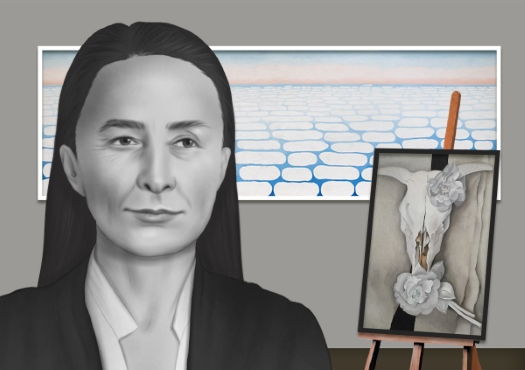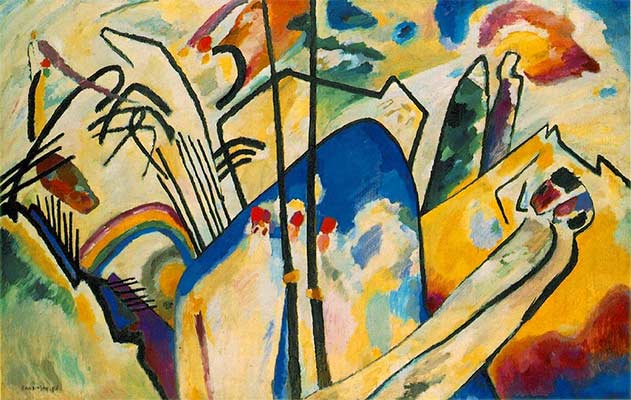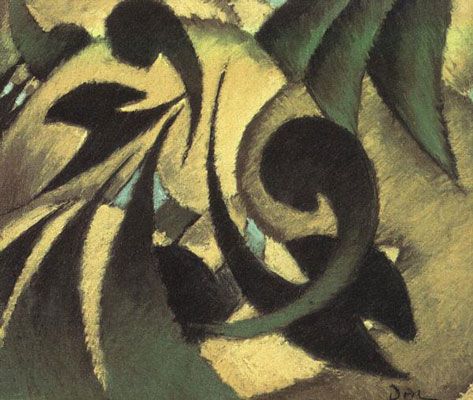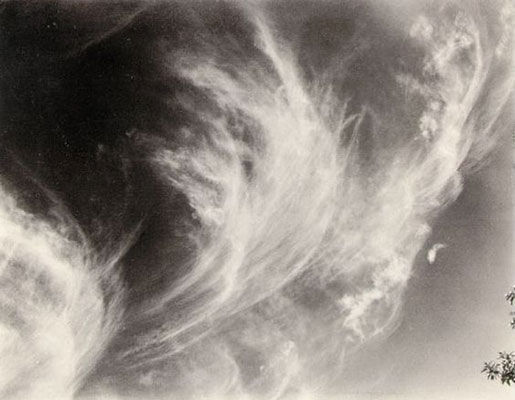Summary of Georgia O'Keeffe
Georgia O'Keeffe played a pivotal role in the development of American modernism and its relationship to European avante garde movements of the early-20th century. Producing a substantial body of work over seven decades, she sought to capture the emotion and power of objects through abstracting the natural world. Alfred Stieglitz identified her as the first female American modernist, whose paintings of flowers, barren landscapes, and close-up still lifes have become a part of the mythology and iconography of the American artistic landscape.
Accomplishments
- O'Keeffe incorporated the techniques of other artists and was especially influenced by Paul Strand's use of cropping in his photographs; she was one of the first artists to adapt the method to painting by rendering close-ups of uniquely American objects that were highly detailed yet abstract.
- O'Keeffe did not follow any specific artistic movement, but like Arthur Dove she experimented with abstracting motifs from nature. She worked in series, synthesizing abstraction and realism to produce works that emphasized the primary forms of nature. While some of these works are highly detailed, in others, she stripped away what she considered the inessential to focus on shape and color.
- Through intense observation of nature, experimentation with scale, and nuanced use of line and color, O'Keeffe's art remained grounded in representation even while pushing at its limits. From the 1940s through the 1960s in particular, O'Keeffe's art was outside the mainstream as she was one of the few artists to adhere to representation in a period when others were exploring non-representation or had abandoned painting altogether.
The Life of Georgia O'Keeffe
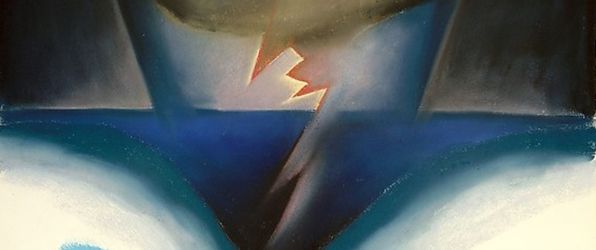
Defining the early New York avant-grade with Alfred Stieglitz, and meditations in vast and desolate New Mexico are some of the sites of O'Keeffe's artistic inspirations and explorations.
Important Art by Georgia O'Keeffe
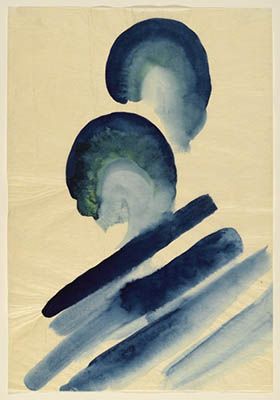
Blue #2
Blue II is indicative of O'Keeffe's early monochromatic drawings and watercolors, which evoke the movement of nature through abstract forms. While the curvilinear form in Blue II is reminiscent of a plant form, O'Keeffe was playing the violin during this period, and the shape likely captures the scroll-shaped end of the neck of the violin that would have been in O'Keeffe's line of sight as she played. The intense blue color suggests that she may have been familiar with Wassily Kandinsky's notion that visual art, like music, should convey emotion through the use of color and line. The intense blue perhaps suggests the sound of the music and the mood it evokes or expresses.
Watercolor on paper - Georgia O'Keeffe Museum
Petunia No. 2
Petunia No. 2, one of O'Keeffe's first large-scale renderings of a flower, represents the beginning of her exploration of a theme that would mark her career. In this painting, she magnifies the flower's form to emphasize its shape and color. She stated that "nobody really sees a flower - really - it is so small - we haven't time - and to see takes time... So I said to myself - I'll paint what I see - what the flower is to me but I'll paint it big and they will be surprised into taking time to look at it." Her flower images often received interpretations that O'Keeffe disagreed with, particularly from feminist critics who saw these paintings as veiled illusions to female genitalia. For O'Keeffe, there was no hidden symbolism, just the essence of the flower. In fact, the anatomy of the petunia is incredibly detailed, and O'Keeffe may have been emphasizing the androgyny of the reproductive parts in order to counter the idea that her subject matter was connected to her gender. Though American and European artists had experimented with abstraction for at least a decade, O'Keeffe, like Dove, focused on images from nature and O'Keeffe was the only artist to consistently use flowers as a motif.
Oil on canvas - Georgia O'Keeffe Museum, Santa Fe
Radiator Building - Night, New York
This painting illustrates O'Keeffe's skill in articulating architectural structures as well as her use of the highly realistic, yet simplified style of Precisionism. She uses the night backdrop to incorporate a play between structure and light, and between the straight lines of the architectural forms and the ethereal smoke, which is reminiscent of the folds of flowers. O'Keeffe's portrait of the Radiator Building, an Art Deco skyscraper that was completed just three years prior to the painting, presents an iconic image that captures the changing skyline of New York City that O'Keeffe often found claustrophobic. She depicts the building from a low vantage point to convey a sense of oppression with the building's towering presence over the viewer. The painting can also be read as a double portrait of Steiglitz and O'Keeffe; Stieglitz is represented by the Scientific American Building, as indicated by his name in red, and O'Keeffe by the Radiator Building. Object portraits of this type, influenced by the poetry of Gertrude Stein, were an important theme for artists of the Stieglitz Circle.
Oil on canvas - Fisk University, Nashville
Cow's Skull: Red, White and Blue
O'Keeffe became enamored with animal skulls after visiting New Mexico. Through the precise rendering of the weathered skull's surface and sharp edges, O'Keeffe captures the essential nature of the skull while also referencing the transience of life. Isolated on the canvas, divorced from its desert context, O'Keeffe uses the cow's skull and the red, white, and blue background to represent both naturalism and nationalism, or the relationship between the American landscape and national identity. Moreover, the subject could allude to the Dust Bowl and the Great Depression, thereby making an environmental and economic statement. What is clear is that O'Keeffe has created a memento mori that elevates this relic of the New Mexico desert to the status of an American icon.
Oil on canvas - The Metropolitan Museum of Art, New York
Black Place, Grey and Pink
O'Keeffe's landscape paintings are similar to her flower paintings in that they often capture the essence of nature as the artist saw it without focusing on the details. In works such as Black Place, Grey and Pink, O'Keeffe emphasizes the wide open spaces and emptiness of the landscape around her New Mexico ranch that she purchased in 1940 - vistas that are the opposite of her claustrophobic cityscapes. Her paintings of the area capture this sense of place and her attachment to it: "When I got to New Mexico that was mine. As soon as I saw it that was my country. I'd never seen anything like it before, but it fitted to me exactly. It's something that's in the air, it's different. The sky is different, the wind is different." The often surprising reds and pinks of the land in these paintings are accurate renderings of the colorful desert scenery.
Oil on canvas - Georgia O'Keeffe Museum
Sky above Clouds, IV
O'Keeffe's subject matter was always inspired by her life and the series Sky above Clouds is no exception, as the painting speaks to her many travels in the 1950s and 1960s. While en route to the Far East, she became intrigued by the view of the clouds below the airplane and sought to render this aerial view in paint as if to symbolize her own expanded view of the world. Remarkably, as she was nearly 80 years old at the time, she began stretching enormous canvases, nearly 24 feet wide, to capture the expansiveness of the scene. This painting, with its high horizon line and simplified clouds that extend beyond the frame, shows the influence of Eastern landscape painting, which also often employs a high horizon line with a broad view of the land. The work underscores that O'Keeffe's art, whatever the motif, remains consistent over many decades: she renders a naturalistic scene or object in such a way as to focus on its essential formal elements and render it abstractly.
The Art Institute of Chicago, Chicago
Biography of Georgia O'Keeffe
Childhood and Education
Georgia O'Keeffe was born near Sun Prairie, Wisconsin in 1887, the second of seven children. She received early encouragement to study art from her mother and took watercolor lessons from a local artist, Sara Mann. O'Keeffe came from a family where female education was stressed and she was fortunate to attend the School of the Art Institute of Chicago from 1905 to 1906 where she studied with John Vanderpoel.
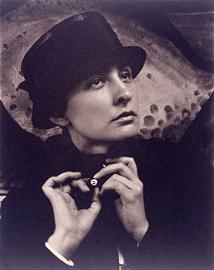
In the fall of 1907, O'Keeffe moved to New York City and attended classes at the Art Students League, studying under the artist-teacher William Merritt Chase. A prize she won for one of her still lifes, allowed her to attend the League's summer school in Lake George, New York. While in NYC, she frequented exhibitions at Gallery 291, which was owned by photographer Alfred Stieglitz and was one of the few places in the United States where European avant-garde art was exhibited. For the first time O'Keeffe was exposed to popular European artists, such as Auguste Rodin and Henri Matisse. She abandoned the pursuit of art as a career in 1908 for four years, taking a job in Chicago as a commercial artist.
She began focusing on her art again in 1912, after attending a drawing class at the University of Virginia's summer school. Her teacher, Alon Bement, professed an innovative teaching style that was heavily influenced by the artist Arthur Wesley Dow. While teaching at Columbia College in South Carolina in 1915, O'Keeffe began to experiment with Dow's theory of self-exploration through art. She took natural forms, such as ferns, clouds, and waves, and began a small series of charcoal drawings that simplified them into expressive, abstracted combinations of shapes and lines. After completing this series, O'Keeffe mailed a few of them to her friend Anita Pollitzer, a former classmate, who brought the drawings to the attention of Alfred Stieglitz in January 1916.
Mature Period
Recognizing her potential, Stieglitz began a correspondence with O'Keeffe. Unbeknownst to O'Keeffe, he exhibited ten of her charcoals at his Gallery 291. He sent her photographs of her drawings on exhibit and this began their professional relationship. While O'Keeffe continued to teach, she returned to New York in 1917 to view her first solo exhibition, arranged by Stieglitz at 291. During this time, O'Keeffe and Stieglitz began a love affair that would last until his death. In 1918, Stieglitz offered to financially support O'Keeffe for one year so that she could live and paint in New York. She took a leave of absence from her teaching position and for the first time dedicated herself solely to making art. Stieglitz divorced his first wife, and he and O'Keeffe married in 1924.
During the 1920s, Stieglitz introduced O'Keeffe to his friends and fellow artists - the Stieglitz Circle - that included Marsden Hartley, Arthur Dove, John Marin, and Paul Strand. Stieglitz and his Circle, as they were called, championed modernism in the United States. O'Keeffe was profoundly influenced by Strand's photography and the camera's ability to behave like a magnifying lens, as well as Charles Sheeler's Precisionism. Following these interests, she began making large-scale paintings of natural forms at close range, and, during this time, also switched from watercolors to oil paint. In addition to flowers, O'Keeffe depicted New York skyscrapers and other architectural forms. By the mid-1920s, O'Keeffe was recognized as one of the most significant American artists of the time and her art began to command high prices.
O'Keeffe's fascination with the landscape of New Mexico began in 1929, when she was a guest of famous arts patron, Mabel Dodge Luhan, at Dodge's ranch near Taos. O'Keeffe became enamored with New Mexico's landscape of vistas and barren land, returning every summer until 1949 to paint. Works produced from this landscape captured the beauty of the desert, its vast skies, distinctive architectural forms, and bones, which she collected in the desert. O'Keeffe's eventual purchase of two properties in New Mexico further connected her to the land.
During the 1930s and 1940s, O'Keeffe's popularity continued to grow and she was honored with two important retrospectives, the first in 1943 at the Art Institute of Chicago and the second in 1946 at the Museum of Modern Art, their first retrospective of work by a woman.
Late Years and Death
In 1949, three years after Stieglitz's death, O'Keeffe moved permanently to New Mexico. In the 1950s, she produced a series of works that featured the architectural forms of her patio wall and door at Abiquiu, one of her two homes near Santa Fe. O'Keeffe began to travel extensively, gathering inspiration for her work. She received many accolades, including membership in the American Academy of Arts and Letters, the Medal of Freedom, and the National Medal of Arts. Despite waning popularity in the 1950s and 1960s, a retrospective held by the Whitney Museum of American Art in 1970 revived her career and brought her to the attention of a new generation of women in the era of feminism. Despite failing eyesight, O'Keeffe continued to produce art, working in watercolor, pencil, and clay throughout the 1970s. Although she had lost her central vision by the age of 84, she continued to paint. Her last paintings consist of simple abstract lines and shapes and hearken back to her early charcoal drawings.
The Legacy of Georgia O'Keeffe
Georgia O'Keeffe spent 70 years making art and contributing to the development of American modernism. She was a prominent member of the creative Stieglitz Circle, influencing early American modernists. She is notable for her role as a pioneering female artist, and although she disavowed their interpretation of her work, she was a strong influence on the artists of the Feminist art movement, including Judy Chicago and Miriam Shapiro, who saw feminine imagery in O'Keeffe's flower paintings. A prolific artist, she produced more than 2000 works over the course of her career. The Georgia O'Keeffe Museum in Santa Fe is the first museum in the United States dedicated to a female artist, and its research center sponsors significant fellowships for scholars of modern American art.
Influences and Connections

-
![Auguste Rodin]() Auguste Rodin
Auguste Rodin -
![Wassily Kandinsky]() Wassily Kandinsky
Wassily Kandinsky ![Arthur Wesley Dow]() Arthur Wesley Dow
Arthur Wesley Dow![Alon Bement]() Alon Bement
Alon Bement
-
![Precisionism]() Precisionism
Precisionism -
![Art Nouveau]() Art Nouveau
Art Nouveau -
![Modernism and Modern Art]() Modernism and Modern Art
Modernism and Modern Art ![Asian Art]() Asian Art
Asian Art
-
![Precisionism]() Precisionism
Precisionism -
![Feminist Art]() Feminist Art
Feminist Art ![American Modernist Painting]() American Modernist Painting
American Modernist Painting
Useful Resources on Georgia O'Keeffe
- Portrait of an Artist: A Biography of Georgia O'KeeffeBy Laurie Lisle
- Georgia O'Keeffe: A LifeBy Roxana Robinson
- Full Bloom: The Art and Life of Georgia O'KeeffeOur PickBy Hunter Drohojowska-Philp
- Some Memories of DrawingsOur PickBy Georgia O'Keeffe, Doris Bry
- Georgia O'KeeffeBy Georgia O'Keeffe, Bice Curiger
 Ask The Art Story AI
Ask The Art Story AI